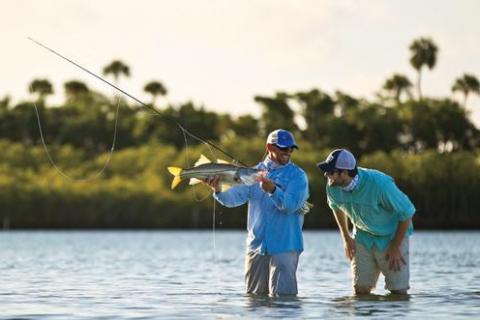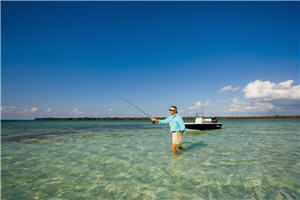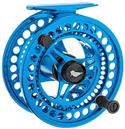
There are many easier ways to catch inshore fish like sea trout, reds, snook and stripers, but there are no more satisfying ways than fishing with a flyrod. The challenge of making the perfect cast, the limitations on distance and the leverage the long rod gives to the fish--plus the issues of line management on larger brawlers--make flyrodding the salt the supreme challenge in angling.
How to Choose the Right Fly Rod
A big part of the battle--once you've mastered the basics of flycasting--is choosing the right tackle for the task. For most applications, an 8-weight fly rod like the World Wide Sportsman Gold Cup will be the sweet spot, light enough to allow comfortable casting for many hours, strong enough to handle anything up to a 20-pound redfish on the flats.
You might consider a 10-weight like the Temple Forks Outfitters Mangrove fly rod if you're inclined to fish mangrov e creeks for snook--the incredible pulling power of these guys definitely requires some serious backbone to keep them out of the tree roots. And the 10 can also double for catching small tarpon--fish to 40 pounds or so are reasonable targets. It's a bit heavy for all-day casting if you're not specifically targeting the larger fish, and this is especially true if you don't get to exercise your fly-casting muscles all that often.
e creeks for snook--the incredible pulling power of these guys definitely requires some serious backbone to keep them out of the tree roots. And the 10 can also double for catching small tarpon--fish to 40 pounds or so are reasonable targets. It's a bit heavy for all-day casting if you're not specifically targeting the larger fish, and this is especially true if you don't get to exercise your fly-casting muscles all that often.
There's also room for a 6-weight like the White River Fly Shop Dogwood Canyon fly rod on the flats, particularly if you mostly target trout. The 6, in expert hands, can whip even a 10-pound red or snook on the open flats, though it's not the tool for fishing them around cover. The action of the 6-weight turns even a 15-inch trout into a formidable adversary, and the light weight makes them a pleasure for all-day casting.
Don't Forget the Right Fly Reel & Line
The reel is an important part of the set-up in saltwater, unlike in flyrodding in freshwater for trout or bass, where it simply functions to hold the line. A saltwater reel is going to have its drag tested repeatedly, and it's going to need adequate capacity to hold both the fly-line and some backing, particularly in the case of taking on teen-age tarpon.
 |
| White River Fly Shop Kingfisher Fly Reel |
Large arbor reels are favored by many anglers because they allow a faster retrieve of line when necessary (there are no gears in a fly reel) and of course the reel must be saltwater-friendly. Models like the White River Fly Shop Kingfisher fly reel are available in sizes from 3/4 to 9/10, and these reels have machined aluminum arbors that are very light--a size 7/8 weighs just 6.7 ounces--and yet have a smooth 9-disc drag system and spool capacity adequate to hold a WF8 line and 125 yards of 20-pound-test braid backing.
A weight-forward floating flyline like the Scientific Anglers Mastery series completes the package for most inshore flyrodding pursuits. "Overlining" or using a somewhat heavier line for a given rod is not a bad idea for casters with less experience--it makes it easier to flex the rod and get the fly where you want it fast, which can be a plus when you're chasing the flats species.
- 5824 views

